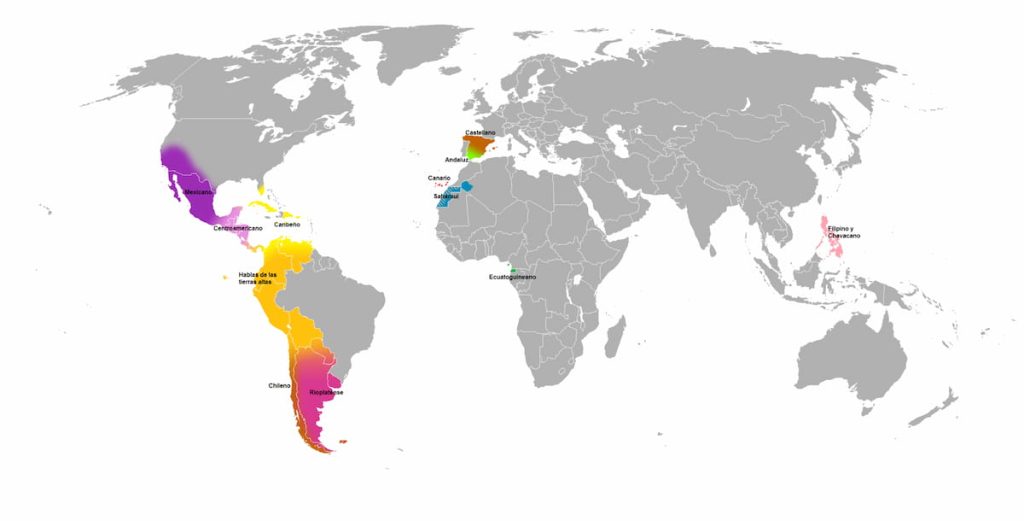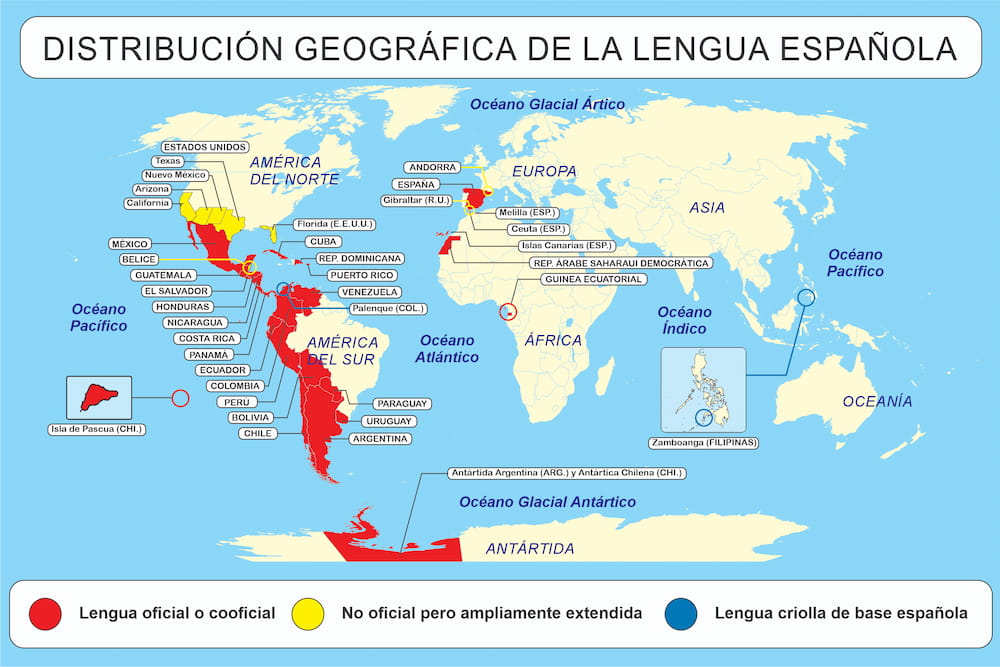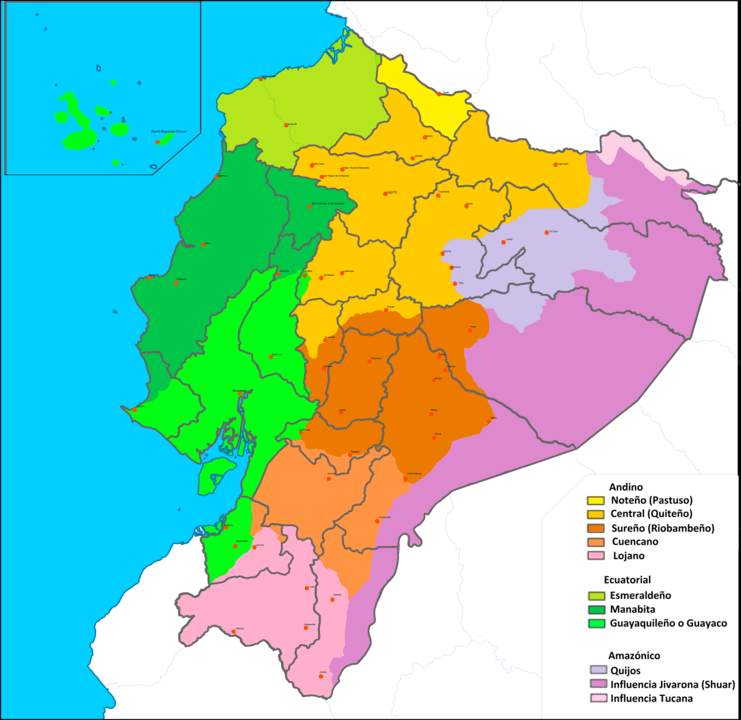With almost 600 million speakers and 21 countries claiming it as their official language, Spanish is one of the most widely spoken languages in the world. This is another advantage of learning Spanish.
The Spanish speakers stretch from Ibiza to Lima to Los Angeles. With such a large area and population to cover, it’s no wonder this language has many dialects, slang, accents, nuances, and varieties — unique to each region.
Comparing the Spanish of Spain with the one of Latin America is a common starting point. But we have to consider much more to categorize Spanish dialects. There is a lot out there throughout the globe.
Let’s take a quick look at the geographical distribution of the Spanish language and its many variants.
TABLE OF CONTENTS
- What is a Spanish Dialect?
- 20+ Most Spoken Spanish Dialects
- Final Words: Which Spanish dialect should You Learn?
What is a Spanish Dialect?

A dialect is a form of the language spoken in a particular area by a specific group of people. In short, it is a regional variation of a language.
The dialect varies from other regional varieties of grammar, expressions, vocabulary, and pronunciation. But all dialects make a single language and are viewed as the primary language.
Like other idioms, most Spanish dialects are mutually intelligible to a large extent. So, if you know standard Spanish, you can easily understand other varieties. The variation extends toward words, phrases, and sounds in a particular locality.
Most Spanish dialects are alike. Yet, a few have distinctive traits. Sometimes it differs so much that it is perplexing if it is another dialect or an unfamiliar language. That is a reason language learning is a complex task.
There are broadly two types of Spanish — Peninsular, i.e., Spanish of Spain, Iberian, European, or Castilian. The 2nd one is Latin American Spanish.
Further, dozens of dialects, creoles, and variations spread across dozens of countries and 5 continents.
20+ Most Spoken Spanish Dialects
If you’re wondering about Spanish dialects — what they are, how many there are, and where they come from — I have all your answers!
Let’s take a tour of Spanish linguistic varieties around the world.

A. Peninsular Spanish
The Peninsular, also often known as Iberian, European, and Spanish of Spain, is the variant widely spoken in Europe. Besides, this is also the most taught Spanish-language version globally.
There are a few different types. Let’s find out.
1. Castilian or Standard Spanish
Castilian Spanish is a variety spoken in north and central Spain. The modern standard Spanish is based on this type.
This widespread of Spanish also started with this dialect. And that is why many linguists refer to it as the original Spanish language.
Vulgar Latin is the root of the Spanish language. The Roman conquest in the 2nd and 3rd centuries BC helped it reach the Iberian Peninsula. This comprises today’s Spain and Portugal.
In the 13th century, King Alfonso X made this version the official language of the government of Spain. Thus, the total administration and documents were used or translated into Castilian.
This political reason allowed Castilian Spanish to become the official language, i.e., De Jure of Spain. So, it became the world’s most well-known and widely spoken Spanish dialect.
The Spanish Royal Academy, publications, and all government bodies use Español to refer to the national language. But Español and Castellano are synonymous and equally accurate.

If your aim is Europe or learning Spanish for careers, Standard or Castilian Spanish is the right choice. The D.I.E. and DELE language exams are also based on this variant.
2. Andalusian Spanish
Unlike Castilian, which is popular in North and Central, Andalusian dialects are useful in Southern Spain. It is widely spoken in Andalusia, Ceuta, Gibraltar, and Melilla and is the second most widespread in Spain.
There is a tendency to drop the ‘s’ and final consonants at the end of words. Sometimes, it also drops the ‘r’ and ‘d’ sounds. As an outcome, the flow and pronunciation are smoother than in other lingoes.
The variation is not limited to sounds but also words, phrases, and slang. Despite Andalusian being a dialect of Spanish, it varies significantly from the northern variant. As a result, it often looks like an entirely distinct language.
3. Canarian Spanish
On the Canary Islands, the Canary Islanders speak the Canarian variant of Spanish.
There is a substantial similarity between the dialects of the Canary Islands and the Caribbean Spanish. For example, it uses the aspirated ‘s,’ elided consonants, and the pronunciation of the letter ‘h.’
Because of Portugal’s past influence on the islands, you can find plenty of Portuguese words in Canarian Spanish.
4. Murcian Spanish
They express this variant in the autonomous community of Murcia in southeast Spain.
It is useful to some extent in the corridor of Almansa in Albacete (Castilla–La Mancha) and Vega Baja del Segura, and Alto Vinalopó in the province of Alicante (Valencia).
The Murcian Spanish dialect resembles and contrasts with the Aragonese, Castilian, and Catalan languages to varying degrees.
5. Castúo
Castúo is another dialect spoken in the autonomous community of Extremadura, Spain. Luis Chamizo Trigueros coined the linguistic term in 1921.
Phonology is close to Andalusian Spanish. In contrast, the grammar rules and morphology have some closeness with Extremaduran and Leonese.
Here, there are simplifications of the consonant group nf to f, rj to j, and rn to nn. The r sound at the end of the world is usually silent.
6. Other Spanish dialects in Spain
While Spanish is the most popular language, there are quite a few more languages in different parts of Spain.
This includes Basque, Catalan, Galician, and Valencian. The total number of speakers ranges from 1% to 8%. Besides, there are recognized but unofficial ones such as Aragonese, Asturian, Leonese, and many others.
Some people believe these are mere dialects. But these are pretty unique and are separate languages. So calling them dialects won’t be correct.
There are also uniquely combined people who speak these languages and Spanish. The accents, vocabulary, and grammar mix give a new kind.
E.g., the Spanish speakers of Basque in the Basque region, Aragonese in Aragon, Galician in Galicia, Catalan in Andorra, Catalonia and Balearic Islands, and Valencian in Valencia.
There are some city-specific variants. For instance, Spanish variety in Madrid, La Manche, and Toledo of the Central-Southern.
B. American Spanish
Christopher Columbus’ discoveries and colonization of South and Central America in the late 15th century led to Spanish expansion throughout the two continents.

With a few exceptions to Brazil, Spain ruled almost the entire region. That is why Spanish is spoken across Latin America.
American Spanish is a group of Spanish dialects spoken in North, Central, and South America. Consequently, there are regional and country variations among the Spanish-speaking countries of Latin America.
There is no broad consensus on this region’s different dialects. Still, here are some of the most popular and distinct ones.
7. Paraguayan Spanish
This group of Spanish dialects is spoken in Paraguay and the border provinces of Misiones, Corrientes, and Formosa in Argentina.
Paraguayan, like other Spanish dialects, also varies in terms of vital vocabulary, expressions, pronunciation, and grammar. But here, the difference is more due to the mix of indigenous Guaraní.
Paraguay is a bilingual country with Spanish and Guaraní as the official languages. Like Spanglish (Spanish and English), there is Yopara, a mix of Guaraní and Spanish.
Since nearly half of the population speaks Yopara, thus, the Guaraní language has much influenced the Paraguayan Spanish dialect. So, if you speak this variant, you will also learn some Guaraní and vice versa.
8. Mexican Spanish
Mexico has the most significant native Spanish speakers worldwide. The Spanish-speaking population is more than twice that of any other nation.
With nearly 99% of Spanish speakers in this enormous country, Mexican Spanish refers to the vast collection of Spanish varieties and sociolects. You can also take the SIELE test to measure your level since it is not based solely on Castilian.
Mexican-Spanish is pretty distinct from Spain Spanish in terms of accents, vocab, and grammar rules. However, they also use lots of colloquial and slang for everyday conversation, which is unique to the local area.
Because of the clear and easy-to-understand sound, we consider it the best Spanish in Latin America. Besides, indigenous tongues like Yucatec Maya, Mixteco, Nahuatl, Tzotzil, and American English impacted various Mexican Spanish dialects.

Broadly, there are 10 different kinds of Spanish in Mexico. Here is the list.
- Altiplano (central variant)
- Bajío (lowlands variant)
- Bajacaliforniense (peninsular northern variant)
- Costeño (coastal variant)
- Chiapaneco (south-eastern like Central American Spanish)
- Norteño del (eastern northern variant)
- Norteño del (western northern variant)
- Occidental (western variant)
- Sureño Central (central southern variant)
- Yucateco (eastern variant)
9. Colombian Spanish
Over 99% of Colombia’s population speaks Spanish. So it looks like one of the world’s most linguistically homogeneous countries.
However, Colombia is a large and culturally diverse nation. That is why the country has many variations, dialects, and accents in Spanish. The variation is mainly because of geographical rather the linguistic reason.
For example, Medellín, Cali, Costal, Insular, Paisa, Chocoano, Llanero, Opita, Cundiboyacense, Caleño, and Santandereano are all different in various ways.
They communicate the standard Colombian Spanish in the capital Bogotá. The sounds are clear, with no strange articulations. Perhaps that is why most view it as neutral Spanish.
10. Chilean Spanish
Chile has several Spanish language varieties. Unlike other dialects, Chilean Spanish is very distinct in terms of unique vocabulary, grammar, pronunciation, and slang usage.
This has tons of colloquial terms, which do not exist in standard or other Spanish dialects of central and South America.
Chile is a long country with distinct classes and regions. Yet, there aren’t many differences between the Spanish of north, central, and south. But there are some noticeable variations in the far north and south of the country.
Chilean Spanish is difficult for Spanish learners, tourists, and foreigners. Too much local slang, expressions, and fast native speaking contribute to this problem.
11. Rioplatense Spanish
We also know this dialect as Rioplatense Castilian or River Plate. They mainly express this in Argentina and Uruguay’s Río de la Plata Basin.
Rioplatense Spanish has taken many words and phrases from European languages like French, English, and German.

In the 18th and 19th centuries, there was an influx of many Italian immigrants in this region, especially in Buenos Aires. As an effect, the tone and accent look similar to Italian.
It differs from other Spanish dialects in several ways. For example, it uses “sh” for “y” and “ll.” Also, it replaces Tú with Vos. This is tricky for those unaware of this dialect since verb conjugation also changes.
12. Caribbean Spanish
The Caribbean island of Puerto Rico, the Dominican Republic, Cuba, and the coasts of Venezuela, Panama, and Colombia are all home to this very dialect.
As a result of omitting some consonants, like R, D, S, etc., the words are typically shorter. For instance, está becomes ‘ta, and para becomes pa. Also, in Puerto Rico, “R” is often pronounced “X” and aspirated.
There is also an influence of words from other languages like English, French, and African. Plus, they have borrowed many words and phrases from the local languages into the Caribbean dialect.
This creates a difference in vocabulary between European and Caribbean Spanish. Plus, this dialect is quick. These make the language difficult for novice learners.
13. Andean Spanish
Andean Spanish is another dialect spoken in the northern part of South America. It is valuable in the central Andes and south Colombia and some parts of northern Chile, Bolivia, Peru, Northwest Argentina, and Ecuador.
It is one of the most widespread American Spanish dialects spread over 7 countries. Due to its presence in a large area, there are wide varieties and subdialects too.
Many consider Andean Spanish the “purest” and most authentic in the Western Hemisphere. Perhaps because the sound in the region is more precise, simple to comprehend, and well-articulated. In short, it is music to ears.
Though clear and soft, the pronunciation differs from the rest of Latin America, the Caribbean, and Central America.
Compared to other dialects, it places a greater emphasis on the final letters of words. It also clearly distinguishes between ‘ll’ and ‘j,’ unlike when they are pronounced similarly in other places.
14. Central American Spanish
Central American has various dialects spoken in El Salvador, Costa Rica, Guatemala, Nicaragua, Panama, and Honduras. It also covers the area of southwestern Mexico.

While most vocabulary is mostly the same, each nation has its own local variations and slang.
Due to the influence of other languages and historical reasons, different accents and sounds exist in a particular region of Central America.
15. Peruvian Ribereño Spanish
Peruvian Ribereño Spanish or Peruvian Coastal Spanish is the form of the Spanish language spoken in the coastal region of Peru.
There are four different Peruvian Spanish.
The Peruvian Coast Spanish is spoken by most people in Peru and is considered the standard language of the country. It is also known as limeños, spoken in Lima. Also, there is a significant influence of foreigners and Andean variants on this dialect.
There are three more: the inland immigrant sociolect, and the Northern and the Southern.
16. Equatorial Spanish
We also know equatorial Spanish as Coastal Colombian-Ecuadorian or Chocoano. They speak mainly in the coastal region of Ecuador and the bordering shore areas of southern Colombia and northern Peru.
This variant shares some similarities with the Caribbean and the Peruvian Coast varieties. For example, the final syllable /s/ is elided or aspirated. Also, the /x/ sound is recognized as [h].

Despite some nearness to other dialects, the northern coastal Peru dialect is a distinct Spanish variety based on phonetic elements.
17. Other Spanish dialects in America
Spanish is using practically all of Central and South America except Brazil.
As a result, there are hundreds of Spanish dialects in South America. For example, Amazonian, Bolivian, Uruguayan, Venezolano, and a few more.
While most are mutually intelligible, some of them also differ immensely. The principal difference is local words, the impact of other languages, and accents.
It is pretty expected for Latin Americans to understand each other with no substantial problems.
C. Spanish Dialects in other parts of the world
Most Spanish speakers live in Spain and North and South America. Still, many people speak Spanish in other parts of the world.
Let’s find out about other dialects of Spanish in different parts of the world.
18. Llanito
The Spanish of Gibraltar is more or less the same as Andalusian Spain. Still, it has some unique vocabulary and borrowed many words, grammar rules, and sounds from British English.
So, the combination of Andalusian Spanish and UK English is called Llanito. Besides, it has also taken many loanwords from other languages like Genoese, Portuguese, Maltese, etc.
19. Spanish in the Philippines
Philippine Spanish is no longer an official language in the Philippines. But once, it had a massive effect on the native languages of the nation, including Filipino, the national language.
Because of their historical roots, many Spanish-influenced creoles came into existence. They are commonly called Chavacano, spoken in many places. While there is no exact figure, it has around 1 million Chavacano speakers.
Filipino contains thousands of Spanish loanwords. The use of Latin scripts in the Philippines is also because of the past Spanish colonial experience.
20. Equatoguinean
Equatorial Guinea is the only African nation where Spanish is the official language. While the exact figure varies, it is home to nearly 1 million Spanish speakers.
Equatoguinean Spanish is closer to Peninsular Spanish than Latin America.
For example, the use of articles is not mandatory. Vosotoros replaces Ustedes, Usted with Tú verb conjugation, and “en” with “a.” Also, there is not much difference between indicative and subjunctive moods.
This African-Spanish dialect also contains pronunciation features and words from native Guineans and German immigrants living in Cameroon.
Final Words: Which Spanish dialect should You Learn?

As you can see, many Spanish dialects are out there.
If you’ve decided to learn Spanish, you may wonder which Spanish dialect would be the most beneficial to pick up for your studies.
It mostly depends on your reason for learning Spanish, goal, and interest.
If you have a specific destination in your mind for whatever reason, favor the dialect of that region. For example, Rioplatense if you want to move to Argentina or work with the Argentinian people.
What if you do not have any specific place in sight? Or want to boost your career requiring Spanish, travel, and expand your personal and professional horizons?
In that case, picking the standard Spanish or Castellano of Spain is a perfect choice. Or, you can go with Mexican Spanish, which is reasonable. It is widely spoken in Mexico, the USA, and some parts of North and South America.
No matter which dialects you focus on and wish to improve, you can understand all Spanish varieties with little effort and practice.
If you feel overwhelmed by this list, don’t worry. You do not need to understand all dialects, as even native speakers experience the same difficulty.
So, unless you aim to live in a remote area, the standard version is what you need for all purposes and passion for this very language.
Do you have any thoughts to share? Let me know in the comments below.









Hi, everybody!
I am writing you to let you know I like this blog because it got stuff very interesting.